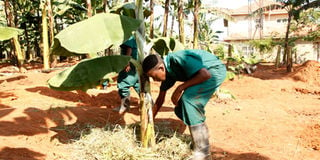Watch out for the banana wilt disease

A farmer mulches his banana plant. Below he the plant. Photo by Rachel Mabala
What you need to know:
Banana Bacterial Wilt (BBW) a disease that affects banana cultivars causes up to 100 per cent losses, writes Lominda Afedraru.
A disease known as Banana Bacterial Wilt (BBW) is ravaging the crop in different parts of the country mainly central Buganda.
The current outbreak in the region is significant because central region and western produces more than 70 per cent of bananas consumed in Uganda, and therefore, could have serious consequences on food and income security of small-scale farmers.
Misusera Mwanje is a farmer from Bukoto South in Masaka District who at one moment cherished growing of the East African Highland banana species commonly referred to as Matooke.
However last year, her field was wiped out by the deadly wilt leaving her in utter confusion. The wilt was first reported in Uganda in 2001.
This was after farmers in Mukono and Kayunga districts reported a “strange disease” affecting their plantations which scientists later discovered was BBW.
It is now prevalent in many banana growing countries such as Kenya, Tanzania, Rwanda, Burundi and DR Congo.
The disease is spread by flies that visit the flowers of the male bud as well as farm tools such as pangas that are used to cut infected crops.
Farmers in central and western parts of the country have been the hardest hit. But there have been interventions to enable them control the spread of the disease especially in the western region.
The plant is also faced with the challenge of black sigatoka disease which causes the leaves to dry up becoming black.
Pests such as nematodes which destroy the banana comb under the soil are other challenges farmers are faced with.
Planting
•Farmers are advised to carryout minimum tillage of the soil therefore spraying of weeds with herbicide is advised and a hole is prepared well for planting of the sucker.
•Dig a hole of three by three feet wide and two feet deep and apply decomposed manure in it to allow establishment of the roots.
•The spacing is three by three metres and 110 plants must be planted in one hectare. Intercropping at early stages is allowed with fast growing crops such as beans but once the plants are four months old it is better to allow them grow solely.
Maintenance
•It is important to remove leaves which have grown old at any one moment, mulching is encouraged to keep the soil wet. Farmers are advised to dig trenches within the plantation which is capable of holding wet soil for about two months.
•It is advisable to weed the plantation continuously to avoid pest and disease infection. Pruning of suckers in essential and three suckers are allowed per a plant family.
•Frequent application of manure containing Potassium is important and Dr Kuriba and team recommend manufacturing of fertiliser specifically for banana containing potassium if farmers are to obtain better yields.
•A farmer who applies manure in his or farmer will be in position to increase the yield to 50 per cent.
•Farmers are also advised to grow highbred variety Naroban 10 which was released last year with high yield potential.
Managing pests and disease infection
•Plants which are infested with pests and diseases must be chopped off into small pieces including the comb in the soil. This will stop the eggs of nematodes from hatching.
•The same applies to a plant infected with BBW and Black Sigatoka. The instrument used for chopping must be burnt in fire before it can be used for cutting another plant. This will stop spread of the disease.
•A farmer who follows this practice will be able to increase the yield of banana cluster from 5 – 11 in a period of two years and will be capable of harvesting 30 – 40 tonnes of bananas per hectare per annum.




